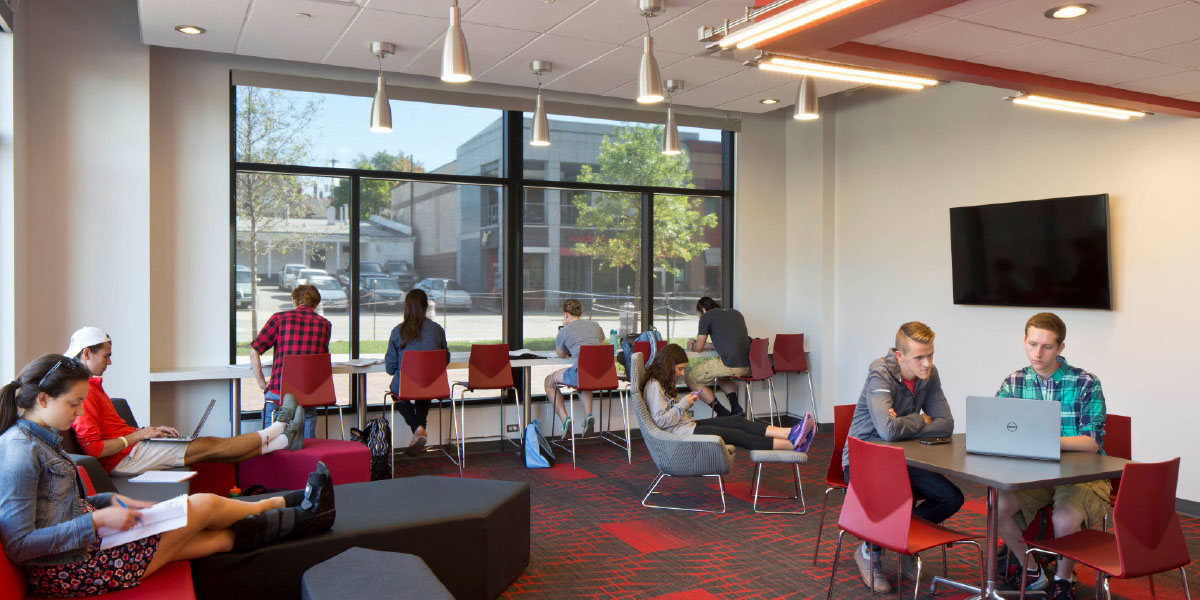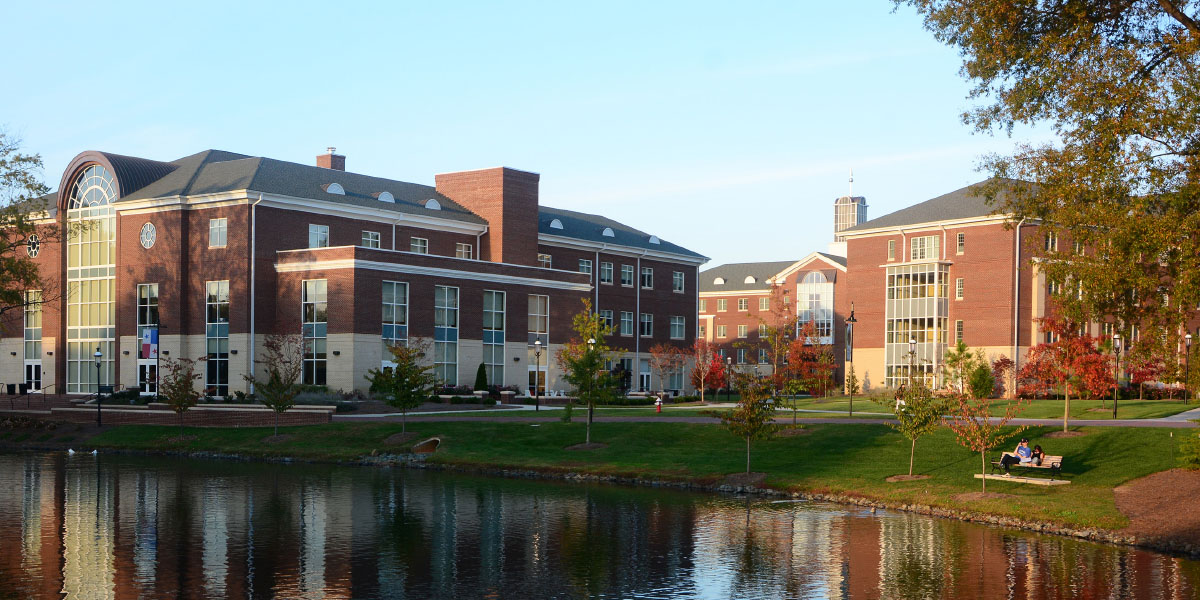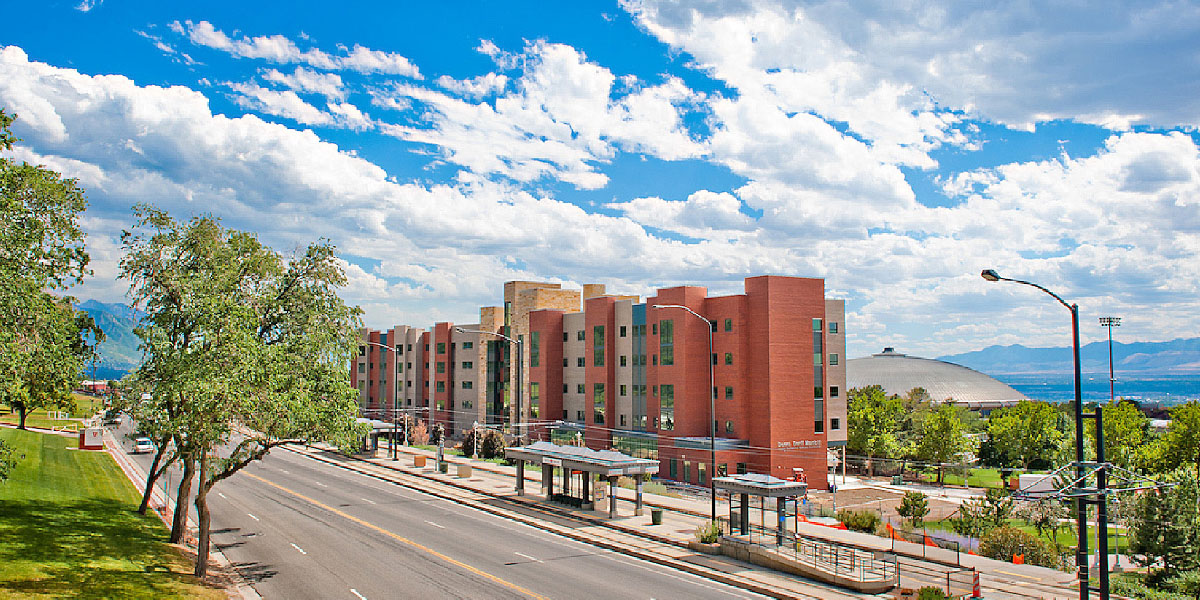Internal research conducted at higher education institutions indicates that students who live on campus perform better academically. In particular, the connection between two key measures of student success—graduation and retention rates—and requiring students to live on campus is becoming more evident. Just ask Michael Papadakis, interim senior vice president of business and finance, and CFO at The Ohio State University (OSU), Columbus. “Those students who lived on campus during their freshman and sophomore years had a 12 percent higher graduation rate than those who did not,” he says.
“Our retention rate is higher for those students who live on campus their first two years as well—96 percent versus 89 percent,” he continues. There are approximately 14,000 beds available on OSU’s campus, and underclassmen occupy the majority of them.
Research at Elon University, Elon, N.C., showed similar data points, according to Gerald Whittington, senior vice president for business, finance and technology. “When I came to the university in 1992, our six-year graduation rate was 58 percent,” he says. “Currently, it’s almost 84 percent.” Whittington attributes this increase to Elon’s commitment to building housing facilities during the last 20 years “to create a residential program that incorporates a seamless experience between curricular and co-curricular experiences.”
The University of Utah’s John Nixon, vice president for administrative services, adds that “knowing that students will have a better campus experience, and thus be more successful academically, makes a compelling case for investing in on-campus housing.” The university’s internal research indicated that students are 12 percent more likely to graduate if they live on campus.
Students who live on campus not only stay enrolled; they excel both academically and socially. Here’s a closer look at how these three institutions have adapted their approaches to residential housing to make the most of the positive correlation between students living on campus and excelling academically.
Reworking Residential Housing: A Trio of Trends
As institutions began tracking student success more closely, they looked at a variety of factors that could improve it. How and where students were housed emerged as key factors influencing their level of academic success.
Given this, institutions also began to rethink their approach to housing requirements as well as the design of their housing facilities. As a result, three key trends emerged that have driven their efforts to reinforce the link between residential living and strong academic performance.

1. Requiring all underclassmen to live on campus. Once upon a time, it was a given that all freshmen students lived on campus. Now the same is true for sophomore students at many institutions that have recently made it mandatory for them to live on campus as well.
OSU’s housing requirement for sophomore students went into effect in fall 2016. “Based on a combination of feedback from students and knowledge that most universities in our marketplace had focused heavily on the first-year experience, we wanted to develop a stronger second-year experience,” says OSU’s Papadakis.
2. Creating mixed-use facilities. At the University of Utah, Salt Lake City, faculty offices, classrooms, and student housing are often combined. For instance, the Marriott Honors Community (MHC) building houses 309 students and is also home to faculty offices, classrooms, and a 24-hour market.
“The goal is for students to take courses together and connect with faculty early on,” says Barbara Remsburg, director of housing and residential education. MHC is one of 25 Living Learning Communities (LLCs) on the University of Utah’s campus designed to bring smaller groups of students together within a residence hall.
3. Co-locating faculty and students. Much like the University of Utah, Elon University has placed an emphasis on encouraging academic and social interactions between students and faculty under one roof. The university’s Global Neighborhood, which focuses on international studies, comprises five residence halls, multimedia rooms, a digital theater, an organic tea cafe, and academic offices.
In addition to providing 595 beds for students, the residence halls include faculty apartments and living space for visiting international scholars. “The closer we can bring curricular and nonclass time experiences together, the more students become engaged,” Whittington says, “and as a result, their grade point averages are higher.”
All three institutions have embraced and expanded upon these trends in their own unique ways, making student success priority No. 1.
Counting on Community
Since the late 1990s, the University of Utah has been moving in a very strategic direction toward becoming a residential campus rather than a commuter campus. “At that time, we were approached by the Olympics organizing committee about housing athletes on our campus,” explains Barbara Snyder, vice president for student affairs. “Working with the committee gave us a rare opportunity to build housing from scratch, and developing a robust campus life program around our growing residential program has really helped with recruitment.”
The university’s initial foray into on-campus housing was the construction of 10 individual houses associated with specific academic departments. “This effort started the collaboration between academic and student services,” Remsburg notes. “We wanted to provide an opportunity to the university’s departmental faculty and advisers to connect with students in their majors, while fostering deep social integration and connection with the university.
“That’s the path we continue to be on,” she adds. “Thirty-one percent of students residing on campus are part of a living-learning community, which sets us apart from our competitors.” Ultimately, the goal is to become a “sticky campus,” according to Snyder, “where we are able to get more students to stay on campus and be involved.”
To that end, with strong support from an outside donor, the university recently invested in Lassonde Studios, a five-story home for student entrepreneurs, innovators, and creators that opened in August 2016. While there is an application process, residency in the studios is open to all University of Utah students. Once accepted, students can choose from four housing types—singles, doubles, pods, or lofts—and live on one of four themed floors, including sustainability and global impact or products, design, and arts. (Read also “Prototype Pivot” in the July/August 2018 issue of Business Officer magazine.)
“For the studios, we used the same framework and strategy of integrating an academic concept with where students live,” Remsburg says. “We have created a top location in the country for aspiring entrepreneurs. Other institutions focus on upper classmen and graduate students, but we wanted to engage first-year students in learning about being entrepreneurs. Gen Z is looking for places to explore ideas while living with other students who share the same mindset.”
Currently, the university can’t require freshmen to live on campus because there aren’t enough facilities to house them, but that’s about to change. Later this year, the university will break ground on a new housing facility that will have 992 beds for first-year students who want to explore careers in the health field beyond the medical or dental professions. According to Nixon, a combination of bonds and funds from generous donors will finance the project.
From his perspective, housing on campus isn’t built based on financial impact. “It’s not something we’re doing to directly enhance the university’s financial position,” he explains. “When you build a new housing unit, you hope to break even during the first year. We’re not looking to make money. This is about supporting our students in their overall academic pursuits.”
At the same time, the university did extensive research to determine its housing needs. “We gathered a lot of information about our need for additional housing,” says Jerry Basford, associate vice president for student affairs, business, and auxiliary services. “Based on that data, we developed a housing master plan to help us address demand, market, and saturation.
“We’re a young housing program,” he acknowledges, “but we have a consistent process for creating pro formas and evaluating proposed housing projects, and thus far they have exceeded financial expectations. We look at housing as a student success initiative.”
And this philosophy is likely to drive the university’s housing strategy for years to come. By 2020, 4,000 students will live on campus. “The value of housing in student success and well-being cannot be stressed enough,” Nixon says. Remsburg adds, “We want to make sure that we can provide access to living on campus to as many students as possible.”

Stepping Up for Success
Similar goals have informed The Ohio State University’s strategy for increasing its residential housing capacity.
To accommodate housing more students on campus, and “redefine the student experience,” OSU began the development of its North Residential District in 2013. According to Papadakis, the $370 million project, which added a total of 3,200 beds, was primarily financed by bond proceeds, with about 10 percent funded through cash reserves. North Residential District is one of OSU’s three on-campus residential neighborhoods, and the project included the construction of eight new residence halls, two dining centers, and a fitness center.
The second-year transformational experience program (STEP) at Ohio State makes use of the full range of facilities, including living-learning spaces within the residence halls. “The main goals were nonfinancial,” Papadakis explains. “We wanted to make sure that we had the best facilities available to support the program, which meant creating facilities with a different design than the older ones on campus.”
STEP was developed to enhance student success, improve student engagement and satisfaction, and contribute to post-graduation success. The program allows students the opportunity to engage in activities that cater to their individual interests and needs. A central feature of STEP is giving participants the opportunity to engage with faculty outside the classroom in one-on-one meetings as well as in group settings. During their time together, STEP faculty mentors help students explore educational and enriching experiences.
Throughout the fall semester, participants meet with their STEP faculty mentors in their “cohort” of about 15 to 18 students to set personal goals and explore the six STEP categories (education abroad, internships, undergraduate research, service-learning and community service, leadership, and creative and artistic endeavors). Based on their successful completion and/or participation in the program, students are eligible for $2,000 stipends to use toward the completion of special projects.
Regarding the fiscal aspects of the project, Papadakis says, “Our financial goal was to break even and be self-sustaining to pay off the debt we issued. We wanted to generate enough margin to set aside and reinvest back into facilities over time.
“The actual rate increases in terms of cost that we’ve passed along to students for the housing component is less than 2 percent,” he continues, “and we initially thought that would need to be higher in order to fund construction.”
Further, OSU tried to keep costs competitive. “We built well-designed, safe facilities that support the program and are competitive within the local housing market in terms of cost from students’ and parents’ perspectives,” Papadakis says.
In general, Papadakis is comfortable with OSU’s overall strategy for aligning its residential life and academic programs with its strategic goal of ensuring student success. “It was a very collaborative process that involved the CFO, the president of the university, and the head of student life working in tandem with other colleagues on campus,” he notes. “Before we launched the full program, we conducted pilots and gathered feedback on what worked and didn’t.” (At the time, Papadakis was the university’s treasurer.)
And so far, the return on investment has been good. The second- to third-year retention rate is 97 percent for the first full class of students in STEP compared to 93 percent for those who didn’t participate in the program. “And we’re just in the beginning stages,” Papadakis says. “Moving forward, we will solicit annual surveys from students and use those to tweak the program each year.”

Navigating the Neighborhood
“We looked at a variety of factors that could improve student success, and the residential program was one of them,” Elon’s Whittington explains. “It’s the largest investment that we’ve made in this area, but not the only one.”
Elon’s campus is divided into eight different neighborhoods, and each of them focuses on a different educational experience, such as civic engagement, leadership, or wellness. According to Whittington, the overall thinking behind the university’s residential housing strategy is that when students who have common interests live together, “they have a deeper and richer educational experience.” To that end, ensuring that first-year students took common core classes together in their neighborhoods was built into the residential life program along with housing that facilitated high levels of interaction among students with common academic interests.
By all accounts, this approach has been well-received. “We have more demand than we can meet for living on campus,” Whittington says. Because of the demand, he is not as concerned about the financial resources that have been used to fund the new housing. “Our financial model for housing is one of debt,” he explains. “We issued debt to build fine facilities with an expectation that the revenue the new beds produce will fund debt service and operating expenses.
“We are still growing, so by issuing debt, we are able to have the effect of the debt service and operating expenses being offset by revenue,” Whittington continues, characterizing this fiscal strategy as one of “no harm, no foul, in terms of the university’s balance sheet.”
At the same time, he acknowledges that some institutions may have concerns about adopting a similar model to expand their residential housing facilities and corresponding academic programs. “What if we stop growing?” he says. “Well, I can always say that beginning now, not only do freshmen and sophomores have to live on campus, but juniors do as well. It’s not the risk that it might seem.
“Still, many institutions will have the question, ‘If we build it, will they stay?’” Whittington continues. “My response would be that it depends on what you build and what sort of programming you have. Are there faculty living there? Are there classrooms and activities in the facility? If your answer is yes, your housing program will be successful. If you don’t make these investments, it won’t be.”
In Elon’s case, the investment has been significant, and so is the commitment to making it pay off. “We have bet the farm on a residential campus experience, so we are very focused on making that work,” Whittington says. “We have fleshed out the skeleton. What remains now is deepening the experiences around what we have built.”
APRYL MOTLEY, Columbia, Md., covers higher education business issues for Business Officer.




 To ensure that students’ residential experience supports their success, institutions will need to focus on three key areas: relationships, research, and recreation.
To ensure that students’ residential experience supports their success, institutions will need to focus on three key areas: relationships, research, and recreation.